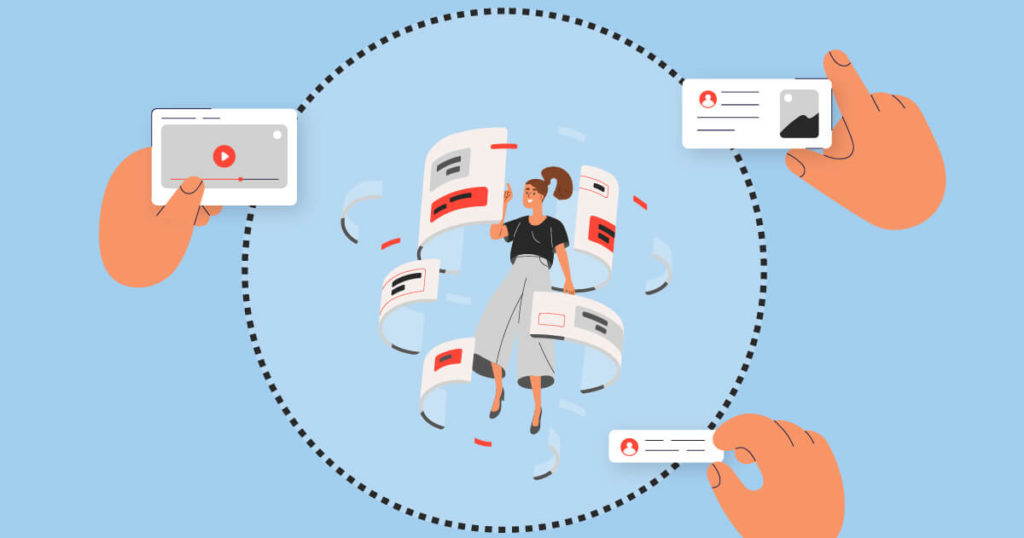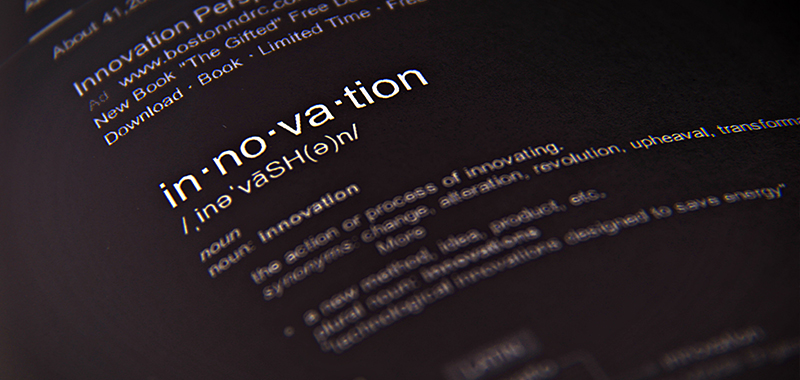
Never file folders again!
How a validatable LMS significantly saves on time and paper
An interview with a representative from the medical technology industry
There will always be challenges to face when converting or introducing a Learning Management System (LMS). However, it becomes even more difficult if the learning platform also needs to map validatable processes. This is a particularly important issue in the medical, pharmaceutical and medical technology industries, as work processes and training courses must be fully documented. We spoke with a representative from the medical devices industry who recently made this type of changeover.

Hans-Heiko Müller, Team Manager for Organisational Learning at pfm medical ag
Hans-Heiko Müller works for pfm medical ag, an internationally operating medium-sized family business from Germany that offers special solutions in the healthcare sector. As Team Manager for Organisational Learning, he is responsible for the documentation of internal training and professional development.
He had already been working with imc's LMS and the imc Learning Suite since 2014 and initiated and oversaw the company's conversion to a validatable system. In this interview, he tells us how the conversion went, what challenges he and his team faced, and how many metres of DIN-A4 folders he now saves.
INFO
The term validation or validation obligation means that detailed evidence that a technical process has complied with requirements must be documented. Simply stated, the aim is to assure the quality of a product in order to prevent serious errors. This is extremely important for eliminating the endangerment of patients in high-risk industries such as the pharmaceutical industry and the manufacture of medical devices.

Hello Mr Müller, please tell us: What do validation processes and learning management systems have to do with each other?
The European Medical Device Regulation MDR and the U.S. Food and Drug Administration FDA impose very strict requirements for this. These requirements state that, if a computer-aided system is integrated into a quality-relevant manufacturing process, documented evidence of this must be provided.
This evidence must show that the system meets the requirements and will perform exactly as specified, both now and in the future. In other words, the system, or in our case the LMS, must be verifiable at all times, and every process must be clearly traceable. This applies, for example, to any changes made to training materials.
At pfm medical, you decided to take the step towards a validatable LMS in mid-2020; how did this come about?
There were several reasons. For one thing, we have to meet the legal requirements, and the European Medical Device Regulation, which was enacted in 2017 and is mandatory as of May 2021, included some innovations that had to be implemented.
Another consideration was the fact that, generally speaking, documentation prior to validation was very time-consuming. We had to carry out a great many procedures manually.

How can I picture this manual documentation?
Basically, all employees must complete certain training courses, for example professional development courses on the individual products. Depending on the type of training, it may need to be repeated or renewed on a regular basis.
Before the conversion, the documentation worked like this: We manually enrolled an employee in the course, and they were able to complete it either online in the LMS or in person. Afterwards, they had to print out a certificate showing that they had taken the test, acknowledge this with their signature and either submit the slip in person or send it by post.
After receiving the letter, we had to check whether the employee was really enrolled on this course and confirm their participation manually in the system. Because we are required to keep these records by law, and in some cases for decades, we manually filed the supporting documents in paper folders.
This added up to about ten running metres of DIN A4 folders within two years. My colleague and I spent several hours each week comparing and categorising. This standard procedure, which is the order of the day in many companies in the medical technology sector, ties up a lot of resources.
That sounds very cumbersome indeed. What does this process look like now with a validatable LMS?
All employees are assigned to different groups, and I can book these groups in specific training courses and onto specific learning paths. The additional professional development courses that are relevant for validation are also found there.
Let's take the example of medical device consultants who have to instruct doctors on our products. If I specify that the group with all consultants must attend a training course on the latest products every year, the system automatically books the entire group into the appropriate training courses. I can also set automated reminders (called escalation management) in the system. This will send a reminder to those who have not completed the training course by a certain time.
Once the employees have completed the course, they can log it directly into the system. To do this, they have to be logged in with their user name and password and also confirm their participation with their electronic signature (e-signature). That's it. We can then see when the employee has completed the training course, and the certificate is stored in the system. We don't have to print anything out or file anything extra.

Can you give us some insights into what was important to you when selecting a vendor?
We not only wanted support with the conversion of the system, but also help with the documentation going forward, because with every update, with every small change I make in the LMS, the potential impact of the change has to be documented. This is extremely time-consuming, and each update quickly adds up to 100 pages.
Theoretically, we could also do this work ourselves, in other words, run through all the scenarios completely and document them. However, I would need to hire at least one full-time employee to do this. We wanted a "comprehensive, worry-free package" that would not only cover the issue of security, but also make our work considerably easier.
What was the actual conversion process like?
First, we worked with imc to create a requirements analysis of the company's learning processes. This involves such aspects as the organisational structure and the structure of the learning content or learning processes. This was followed by the reconciliation of validation documents and the provision of user requirements and functional requirements including risk analysis.
Then, in the planning phase, we were provided with a development system (DEV system) for initial workshops. In the workshops, for example, the administrators were trained, and we set the system up and used it on a test basis together. In the third phase, a test system, or STAGE system, was put into production, and this in turn was tested. This was followed by the deployment of the productive system.
The process took just under four months altogether. If we had done it completely on our own, it would have taken us an estimated 18 to 24 months.
Did you have any fears or anxieties about the conversion beforehand? How did you deal with them?
Of course, we had respect for a project of this magnitude. But we saw the conversion as an opportunity to bring the old world into the digital age. For example, we took another look at all the processes and checked to see where they could be streamlined.
As a result, we now have training processes that are uniform for all employees, including those of our subsidiaries. There was a real change in culture which was also initiated by the fact that we worked with so many different departments.
At the same time, this presented a certain challenge, in that we first had to find out which "language" everyone spoke. Terms such as system or DEV system can be interpreted differently by each department. For example, since we worked with HR as well as IT, it was immensely important to make sure that everyone knew what was meant by which term. Clear agreements and a regular exchange are essential for this.
Were there any other challenges?
Personally, I didn't find it easy to relinquish some of the responsibility and rely on an outside vendor, because as I mentioned, I had already been working with the LMS since 2014, knew how it worked, and could make changes myself.
During the conversion, however, it was the provider, and not I who worked on the system. In a way, that was a leap of faith, because I didn't know exactly what was going on in the background. It made me a little nervous at first. However, we agreed on short sprints, in other words, weekly coordination meetings with the possibility of readjustments, so that I was reassured and could follow where we were in the process at any time.
However, you should be aware that you lose some flexibility with this sort of system. Changes that I could previously make myself with a check mark are now locked and have to go through a change process which has to be applied for, checked within the context of a four-eyes-principle and documented before it can be implemented. This strict process ensures the prescribed safety, but the price is less flexibility. Still, the advantages clearly outweigh the disadvantages for pfm medical.

What would you recommend to companies facing the decision to have their system changed?
My advice: You have to take a careful look at the processes in advance and then have the courage to adapt them to the technology. Not the other way around. This way you can be sure that there will be no problems during audits.
Thank you so much for all your insights!
Further information
Curious to find out more about pfm medical's validatable LMS? Then check our reference page.
Or download the whitepaper about how to master validation with an LMS.
Not enough? Then watch the webinar recording with Hans-Heiko Müller related to the topic validation in a LMS (German only).

How not to break bad with validated processes in an LMS
What requirements must an LMS map for validated processes? And how does Breaking Bad fit here? Questions about questions not only the Pharmaceutical industry should think about.

Learning Analytics: It comes down to the right questions
Learning must not be an end in itself, but fit in the company’s business outcome: More and more managers are demanding this. We therefore looked at how L&D managers can meet this requirement with the help of Learning Analytics.

More about our LMS
If you would like to learn more about imc's Learning Management System, check here for more information.

Contact person
I have been working in the Marketing & Communication Team at imc since March 2019.
Communication, creative content and social media are my passion. "KISS - Keep it short and simple" is my credo.
To explain complex content in an understandable way and thus make the topic of e-Learning accessible to everyone is an exciting challenge every day.
Privately I love to read, play poker and travel a lot.
I am always happy to receive feedback or suggestions.

Requirements an LMS must map for validated processes
... and how the series “Breaking Bad” would have stood up against 21 CFR Part 11
Do you know why pharmaceutical and medical companies might envy Walter White, the drug chef from “Breaking Bad”? Well, in contrast to those producing legal medication or medical products, he never had to deal with validated processes in a Learning Management System (LMS)! We reveal the processes suitable software must map if patient health is of concern, and where 21 CFR Part 11 comes into that.
Good to know
The US-American series “Breaking Bad” revolves around 50-year-old chemistry teacher Walter White. After being diagnosed with lung cancer, he starts a career as a drug chef and is caught in a downward spiral. The series received many awards around the world, and aired in the USA from 2008 until 2013.

What does the FDA regulate?
Let’s assume anti-hero Walter White and his companion Jesse Pinkman had managed a regular pharmaceutical or medical company. They would then be subject to regulation by the U.S. Food and Drug Administration (FDA) like all companies in this high-risk sector.
As a government agency under the U.S. Department of Health and Human Services, the FDA imposes strict rules on companies that manufacture food products, drugs and medical devices in general. All companies offering their products and produce in the USA are bound by these rules. In addition to the FDA, the European Medicines Agency (EMA) also enacts such rules through the EU. This also includes good practice guidelines (GxP).
Info
GxP guidelines include GMP and GCP guidelines, which relate to the correct processes (Good Manufacturing Practice: GMP) and Good Clinical Practice (GCP) that must be applied in the production of medicinal products and substances.
Keeping with our analogy, Walter’s opponent, police investigator Hank Schrader, would have worked for the FDA instead of the Drug Enforcement Agency (DEA), and supervised the proper and traceable production.
Validation requirement pursuant to FDA 21 CFR Part 11? What?!
Imagine, Walter and Jesse had now established the legal company “Heisenberg Limited”. To ensure that their substance – sorry, the drugs – stay pure and are produced in a sterile environment to the highest hygiene standards, production takes place in a cleanroom instead of a caravan.
However, the only way to access this cleanroom is via an electronic airlock secured with a card reader. Only individuals who have passed the training course “Conduct in sterile rooms” in the past 12 months have access. Jesse would therefore have had to complete proper training first, rather than being trained on the job by Walter.

A Learning Management System assumes the airlock and access control, only allowing suitably trained personnel to enter. Given that this makes the LMS an integral part of the production process and errors could put patient lives at risk, it is subject to a section of the Code of FDA, which is entitled 21 CFR Part 11 (CFR: Code of Federal Regulations).
In 21 CFR Part 11, the FDA formulates its requirements for producers of pharmaceutical and medicinal products in relation to all electronic records that are digitally created, amended, stored, transferred or accessed in any form. This can be in the form of texts, images, videos or audio files [Source: Johner Institut].
The validation requirement applies, demanding documentation of detailed proof that a technical process fulfils the requirements. Basically, this aims to assure the quality of a product to prevent serious errors. After all, nobody wants to produce or take drugs that are ineffective or even harmful.
Definition validation
- Validation means furnishing proof that a process permanently produces a product according to specifications and quality standards with a high degree of assurance.
- Validation of a computer-based system means the documented proof that the system satisfies the regulatory requirements, and that it currently works as required according to the specifications and will continue to do so in the future.
[Source: FDA Guidelines on General Principles of Process Validation]

“Never trust the user”: What a system must fulfill
To prevent this, production is guided by the following two mottos: Never trust the user! And: Anything that can be checked will be checked. To minimise human error, the FDA requires that any system used in this production process is validated and performs visible functions of such a validatable system, which include:
1. Audit trail
All data must be available in valid form, traceable and logged automatically, and it must be possible to export it. All modifications, planned courses and registrations are recorded using audit trails. Moreover, defined rights and roles must be clearly visible. It must be possible to trace at any time, what was changed when by whom and in which form.
2. Electronic signature
An electronic signature can be defined as a requirement for the performance of certain critical actions. Changes may then only be carried out by authorised persons, who must confirm their authorisation with their user ID and password. This might apply, for example, to the approval of tests or the registration of learning content.
3. Versioning (approved records)
All learning content – from courses through course templates, learning path types, test questions, tests and certificates to cost centres or cost types – are subject to versioning. Any time the object characteristics are edited, the latest version of the object is stored in the system as a numbered version, and published if required. That means older versions cannot be lost. After all, modifications might need to be stored and documented for several years.
[Source: German only: §20, Prescription of drugs and active ingredients]
But that’s not all: Once these requirements are met, Heisenberg Limited must use validated processes to ensure that a risk analysis is carried out for each process and function before it is implemented, including the LMS. What happens if a user from category Y with X rights clicks Z button? What potential errors exist, and what is the effect resulting from these errors? What risks or dangers does an error create for the patient?
This can only be successful, traceable and verifiable if roles, processes and rights are clearly defined. The same applies to things like authorisation concepts and patches.
Validation good – all good – deal?
If this is starting to give you a headache and you’re tempted to reach for pharmaceutical products like headache medicine to ease that, we won’t be of much help. However, if you decide that you want to learn more about validation, we can offer you a deal.
Take a look at our webinar recording on validiation and LMS (German only). Or send us a message. We really are nicer than the DEA or FDA. That’s a promise!

LMS Business Case: Why the gains outweigh the costs
A Learning Management is far too expensive? Not if you use it in the right way! Even more: For most clients, an LMS pays for itself within a year. We tell you how to prove that with a Business Case and answer some FAQs.

Learning Analytics: It comes down to the right questions
Learning must not be an end in itself, but fit in the company’s business outcome: More and more managers are demanding this. We therefore looked at how L&D managers can meet this requirement with the help of Learning Analytics.
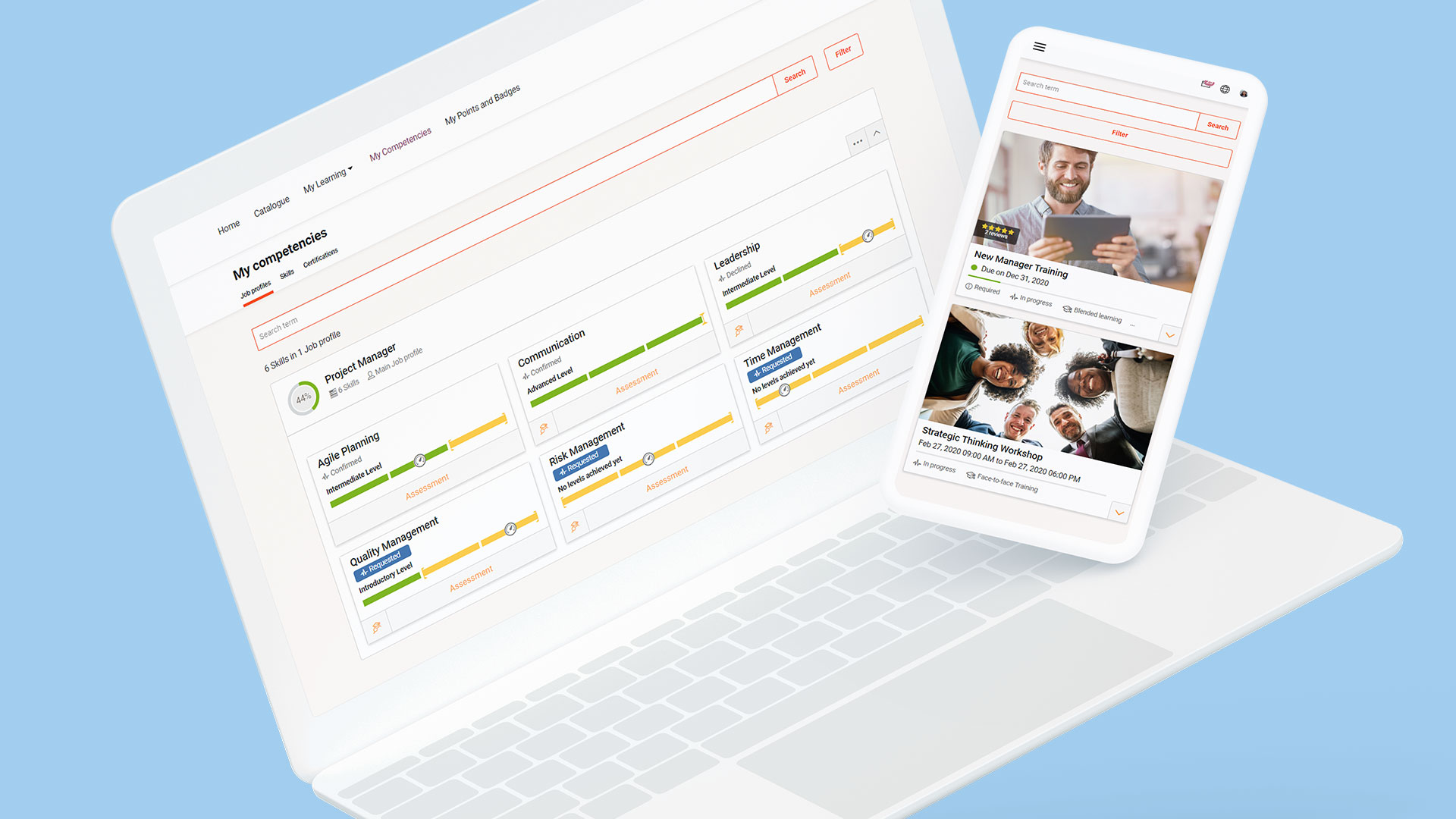
More about our LMS
If you would like to learn more about imc's Learning Management, check here for more information.

Contact person
I have been working in the Marketing & Communication Team at imc since March 2019.
Communication, creative content and social media are my passion. "KISS - Keep it short and simple" is my credo.
To explain complex content in an understandable way and thus make the topic of e-Learning accessible to everyone is an exciting challenge every day.
Privately I love to read, play poker and travel a lot.
I am always happy to receive feedback or suggestions.

Topics, trends & tools all around LMS
"LMS Hot Topics" is a series of articles dealing with all topics related to Learning Management Systems. No matter if you are already a real LnD-Pro with years of experience in the support of an LMS, or if you just want to get started - there is something for everyone here.
Topics, trends and tools

Learning Management Systems (LMS) and everything that goes with it is what "LMS Hot Topics" is all about. The latest trends and tools are presented as well as various application possibilities and best-practice applications.
Whether E-Learning novice or LnD-Pro, "LMS Hot Topics" offers a broad spectrum of topics, interview partners and practical tips and tricks.
Do you have a topic or an exciting use case that we should report on? Then contact us!

LMS Rollouts: Theory vs. Practise
Checklists often sound easy. But practice is different. That's why we're sharing some customer insights.

First impression count!
First impression count! Also when it comes to implementing a new learning platform. We tell you which pifalls to avoid.

The Netflix Factor in Self-Directed Learning
Self-directed learning and Netflix have a few things in common! We find out what and where the limitations lie in corporate learning.

Diary of an LMS
If an LMS wrote a diary - what would it say? We thought about that and share some tips for LMS professionals, told a little differently...





More information about the LMS
If you would like to find our more about the Learning Management System of imc, please find all information here.
Contact
I have been working in the Marketing & Communication Team at imc since March 2019.
Communication, creative content and social media are my passion. "KISS - Keep it short and simple" is my credo.
To explain complex content in an understandable way and thus make the topic of e-Learning accessible to everyone is an exciting challenge every day.
Privately I love to read, play poker and travel a lot.
I am always happy to receive feedback or suggestions.

Why the gains from a learning management system outweigh its costs
...and how you can prove that with a
business case

We have no money. Who is meant to take care of it? And what’s the point anyway? These are some of the most common arguments and concerns brought forward when the topic of learning management systems (LMS) comes up. However, many decision-makers miss that the payback period for such an investment is incredibly short – provided the system is implemented and utilised in a consistent and meaningful way.
It’s easy to show that this is not just an empty marketing claim when basing calculations on a business case. You run through a scenario, examining strategic, economic and managerial, as well as process-based aspects. We spoke to Sales Manager Svenja Kreten who has created business cases many times over.

Svenja Kreten, Sales Manager at imc
She is convinced: “For most clients, a learning management system pays for itself within a year. I can demonstrate that using figures validated together with the companies in question.”
In our FAQ, we summarised in easy terms how she obtains those figures, what a meaningful business case calculation should look like and what factors to include.
What is a business case?
A business case is useful for evaluating the investment in an LMS. It helps to illustrate costs, benefits, risks and time investment better. It makes the company’s payback period for the LMS transparent and clear.
Arguments like “too expensive, not worth it” can easily be proven wrong with facts and figures: Functional benefits such as time savings, learning success, administration costs and realisation of revenue potentials can be broken down accurately.
Why develop a business case?
A business case examines the feasibility of an investment. A calculation is performed on the project, providing the relevant indicators. In principle, a business case can be used for a vast range of circumstances. It’s always useful when looking at long-term or cost-intensive acquisitions. That definitely makes it a worthwhile exercise for the introduction of a learning management system.
The exact figures of the company’s spending are clearly defined - for example expenditures for the employees’ professional development. Specific expenditures are examined, like those incurred through manual administration of employee training courses. This includes both labour costs (human resources) and material costs (copies, name badges, etc.). The analysis also extends to parameters that directly or indirectly impact revenue growth.
What is measured in an LMS business case?
The focus is on the cost savings the learning platform offers compared to traditional employee training measures. Costs and revenue potentials are both equally examined.
First, all expenses related to training and professional development are listed. Step two involves the evaluation of factors affecting revenues. Based on these cases, secondary calculations can also be used for specific departments of the company. Topics like new employee onboarding can be analysed separately.
How does the calculation work?
The calculation on an LMS business case looks at the entire training and professional development process. Along this process, the parameters that can be influenced by the LMS are filtered out.
This includes some trivial aspects, like travel cost savings achieved by moving training courses from a face-to-face format to a virtual one. More complex parameters might include a reduction in the production error rate through more efficient training, or revenue increases through a shorter time-to-market cycle. These parameters are then quantified.
Example of an LMS business case
Let’s look at an example to illustrate this: On average, a company trains its 1000 employees for 2 hours per year. For 15% of the employees, this training is a repetition that delivers no new insights. For 10% of the employees, the training is irrelevant, as the learned material is not needed for their work.
Thus, a total of 250 employees was kept from work unnecessarily for 2 hours each. In other words, the company lost 500 hours of labour. Whether or not the affected employees would have been working productively in that time is irrelevant.
The fact remains that they attended a training course that cost money but brought no benefits. In the worst-case scenario, they may even be demotivated and more stressed after this training exercise, as they need to catch up on lost time.
A well-maintained and carefully managed LMS can avoid such unnecessary training, as comprehensive competence management is employed to automatically match each employee with the most suitable training courses. Of course, this requires system data to be checked regularly and in full, and analysed by specialists.
Or as Svenja Kreten puts it: “The figures we present with the business case are real-life figures. We have our assumptions for every single calculation verified by the companies or specialist departments in question.
An LMS only becomes expensive if it’s not used properly after implementation. Yet, when a company manages to achieve a long-term reduction in even just some of the highlighted unnecessary costs – like duplicate training courses – the system pays for itself very quickly.”
More information
Would you like to learn more about how to choose an LMS? Then check this free whitepaper about finding the right LMS.
If you would like to get in touch with us in person, please feel free to use this contact formular.

How to: LMS migration
When a new learning management system (LMS) is needed, sound advice is hard to come by. We have collected tips from industry experts, and summarised the key questions and answers in our FAQ checklist.

Onboarding slightly different
Already today, onboarding can be integrated into an existing LMS. But this is hardly ever used.
We took a little trip into the (near) future to see what a successful onboarding process could look like.

More information about the LMS
If you would like to find our more about the Learning Management System of imc, please find all information here.
Contact
I have been working in the Marketing & Communication Team at imc since March 2019.
Communication, creative content and social media are my passion. "KISS - Keep it short and simple" is my credo.
To explain complex content in an understandable way and thus make the topic of e-Learning accessible to everyone is an exciting challenge every day.
Privately I love to read, play poker and travel a lot.
I am always happy to receive feedback or suggestions.

Don’t call it compliance!
5 success factors for effective realisation of
"boring" trainings
Spontaneous yawning, irritated eye-rolling and sudden appearance of urgent appointments are some of the most common side effects of announcing the latest compliance training. Yet, it is crucial that employees internalise the learned content from important training courses on topics such as data protection or fraud prevention for the long term. This can only be achieved if the learning experience is great. We reveal how that can be done.
“It really is very simple: The more complex and dry a topic, the better the experience needs to be for the learner,” Sven R. Becker, learning expert and Member of the imc Executive Board sums up. As much as the learning experience is hyped up and features in the learning management system (LMS), it often falls by the wayside in company-specific training.
Topics like the latest GDPR provisions or IDD training as soon required in the insurance sector might not be met with great enthusiasm – but they are extremely important. Employees not only need to understand these topics, they must also internalise them and apply them in their daily work.
Creative realisation of dry topics like fraud prevention
Audi is leading by example. The automobile giant ventured to try a courageous concept: Web-based training modelled on “Sin City” is leveraged to train all employees in fraud prevention. Right from the outset, it is obvious that this training course is different. Usually, a participant would click “Start training now” to make a start on their training course. Here, they are greeted with the following text: “Welcome to Fraud City. The city “eats” its residents – skin, hair and all. We hope you’re up to it. Enter at your own risk.”
Throughout the course, the participant accompanies Detective Fraudless who investigates fraud cases. In this game setting, the participants become familiar with the criteria used to identify cases of fraud while also becoming sensitive to suspicious behavioural patterns.

Laura Schumacher, Training Officer at Audi, emphasises: “We very deliberately wanted to provide a different kind of training course that is fun and sticks with you, especially for this sensitive topic.”
This unusual concept is paying off: On the intranet, countless Audi employees made largely positive remarks on “Fraud City” – rather remarkable for compliance training.
Standard training for ever-changing guidelines
Since not everyone can justify the time and expense of highly customised training courses, a large selection of off-the-shelf content (OTS) is also available. In particular, this is a suitable solution for contents or certifications requiring adaptation due to regular updates, legislative changes or new guidelines.
Such off-the-shelf training courses fit the bill for product training required in the insurance, banking, pharmaceutical or medical sectors. It is, however, important that providers hold relevant certificates and accreditations and are able to guarantee automated learning content updates.
TIP
Ensure that your provider is an accredited educational service provider and guarantees that content is always up to date.
These standard training courses can easily be mapped in the LMS and facilitate complete documentation and certification of all employees. Vivian Porath is responsible for OTS contents at imc. She is confident that these training courses need not be boring at all:
We have received outstanding feedback from our clients, especially on our standard data protection training. Our clients feel the design hits the spot, being neither too comical nor too serious.
One reviewer stated that they thought the training course achieved a perfect technical balance. Other courses they attended had been either too superficial or looked at the subject in such depth that they had switched off. We were thrilled to hear that. After all, we strive to present the GDPR in such a way that anyone can gain from it. Many employees have no need to dive deep into the subject matter. Rather, they must be sensitised to the topic in general.”

Vivien Porath
It still holds true: Employee motivation and a great learning experience are key. Without them, learned content is forgotten faster than you can close the next cookie banner.
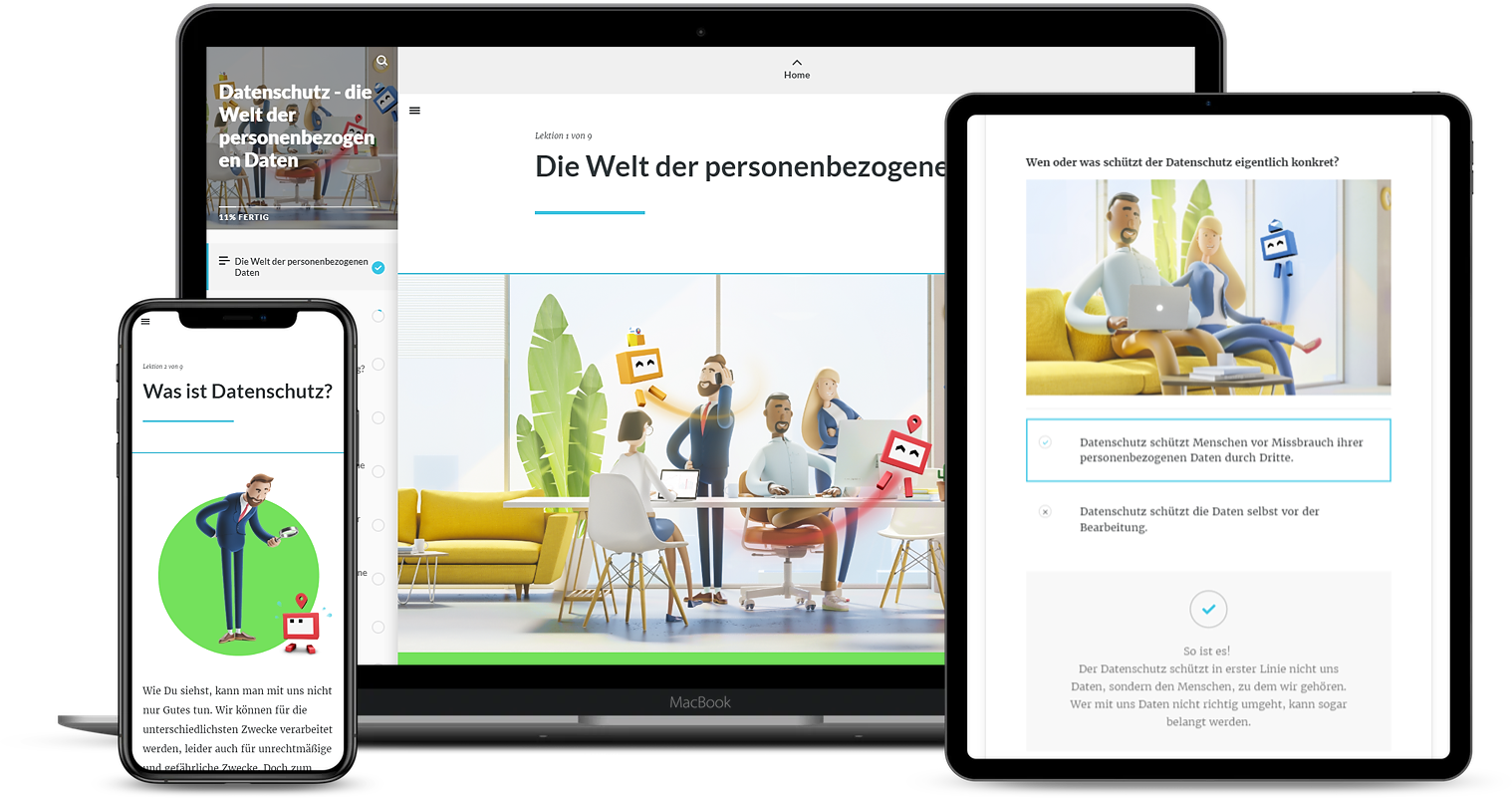
LMS integration
Training alone is not enough – whether based on customised or standard content. Traceability must also be ensured. This is best done with a suitable LMS that allows admins to allocate relevant training courses to each target group, and should also include setting end points and establishing escalation management.
Say, for example, insurance expert Ms Smith belongs to a group of employees who must earn a specific number of IDD points . The administrator can create an automated alert for relevant courses in the system. If she fails to complete the training by a certain date, she will receive repeated email reminders. At a pre-defined date, her direct supervisor can also be informed.
INFO
Since 2018, all insurance intermediaries throughout Europe have been obliged to undergo further training within the framework of the Insurance Distribution Directive (IDD). The number of obligatory training hours varies from country to country.
What to base your choice on
What should clients pay attention to when buying compliance training? Sven R. Becker summarises:
1. First of all, understand your target group. Does the target group need to acquire in-depth specialist knowledge? Or is sensitisation the primary goal? Your answer to this question must be reflected in the technical presentation.
2. It is generally advisable to establish a basic understanding for sensitive topics across the entire organisation, a compliance mindset. Each training course and each measure must be positioned within this mindset. It is crucial that management is setting an example. Integrating senior management into the training course is often helpful, and asking them to design realistic case studies can help learners see how the content applies to them.
3. Standard training is better suited to content more general in nature, as the provider must ensure that it is up to date. However, if a topic is specific to a sector or even just the company, it helps to customise at least parts of the training and only filling the gaps with standard content.
4. Ask yourself for how long you want to use a training course. If contents requires frequent adaptation, OTS content is often a better choice – provided that certifications and updates are guaranteed.
5. Don’t call it compliance training! The term alone is like a red flag for many employees. It pays to be brave and find a different name. Surprise your learners with training courses that polarise and stand out. This makes your contents more memorable than with run-of-the-mill courses. And maybe you can even have your employees enjoy the training – without the yawns.
Further information
If you would like to learn more about off-the-shelf content or our custom content, please check the related pages and feel free to contact us.
You can also check this webinar recording (German only) about the topic of compliance.
Contact
I have been working in the Marketing & Communication Team at imc since March 2019.
Communication, creative content and social media are my passion. "KISS - Keep it short and simple" is my credo.
To explain complex content in an understandable way and thus make the topic of e-Learning accessible to everyone is an exciting challenge every day.
Privately I love to read, play poker and travel a lot.
I am always happy to receive feedback or suggestions.

The (ideal) relationship between corporate goals and learning analytics
When a company needs to cut costs, L&D departments are often the first to feel the pinch. Professional development costs money without providing a tangible benefit. That is, the lack of directly verifiable benefit is often cited. However, L&D organisers can disprove this assumption if they examine learning analytics in more depth. We are answering the most pressing questions on this topic and offer practical tips.

It comes as little surprise that corona has driven investment in digital training platforms and e-learning in general. Yet, this is not a new trend. Back in 2019, figures published by Fosway Group already pointed in this direction: More than 60% of the interviewed companies stated that their expenditure for learning platforms and e-learning contents had significantly increased.
Greater numbers of digital training courses and higher costs drive demand for higher quality learning content, while also intensifying the focus on the actual business outcome. What exactly are employees learning? What purpose does it serve? How does it help my company’s development? How can I determine the impact professional development has on my revenue, for example?
This is exactly where learning analytics comes into play. Here’s a quick outline of what that is all about, and how to map business outcomes in a meaningful way.
What does learning analytics mean?
The term “learning analytics” comes from the traditional IT sector. It means that data on learning and learners is analysed to arrive at decisions based on this data.
Where is learning analytics applied?
Traditionally, learning analytics methods are used wherever learning data is generated. While different analysis tools are available, this is typically done directly in a company’s learning management system (LMS).
What is measured?
Typical examples would be information on the number of participants booked onto a particular course, the total e-learning hours booked in a given month, or the number of certificates issued.
However, this is all fairly basic information that offers little insight by itself, and should be linked to other reference points.
How should learning analytics be used?
Things become really interesting when learning analytics is leveraged to look at selected data in relation to other data, and analyse it in terms of the business outcome.
An example: One region is experiencing a more pronounced increase in bookings for training courses and course completion. Yet, revenues are stagnating. Meanwhile, revenues in a comparable region shows strong growth after the same number of training hours. The analysis now needs to dig a lot deeper to draw sound conclusions from these figures.
The right questions need to be asked. For instance: How did the participants rate the courses? Did the booked courses match the learners’ skills level? Did the courses challenge too much or too little? What was the dropout rate? Did the course content cover topics relevant to employees in that region?
If the answers show a discrepancy between course content and expectations, this can be addressed directly. At this point, artificial intelligence (AI) technologies can also be integrated to develop recommendations for action.
How does the analysis with LMS dashboards work?
Learning management systems provide a variety of role-specific standard reports, which provide information on qualitative and quantitative elements of learning.
In addition, it is possible to select relevant data and use it to create customised reporting dashboards, for which automated generation on specific dates can be set up. The results can be visualised through pie, bar and line charts, as specified for each analysis.

Wolfram Jost, board member in charge of products at imc calls on companies to look at the relationship between business outcomes and learning content, offering the following summary: “Learning analytics must be leveraged to promote employee performance in a way that supports corporate goals and business outcomes. The value created through professional development programmes only becomes apparent when corporate figures are included in the analysis.”
His three top tips to get started with learning analytics and business outcomes are:

Dr. Wolfram Jost, board member at imc
1. Less is more
Select data that is truly relevant, and use it as a basis for simple dashboards that provide a clear overview. Information overload leads to confusion.
It is also important to pay attention to data protection requirements, and to keep asking yourself what data is necessary for a meaningful analysis.
2. Data is King
While large quantities of data (massive data) are needed to run an analysis in the first place, it only becomes truly reliable if that data is also of a high quality and reports are generated on a regular basis. Continuity and regular data updates are crucial.
Moreover, data must be presented in a form that allows the relevant stakeholders to interpret the resulting data in a meaningful way to harness its full potential.
While data should support decisions made by people and data analysis is a useful tool for decision-makers, it still needs to be scrutinized. “Dictatorship of data” - assigning data actual decision-making powers - should be avoided.
3. Trend is your friend
One-off figures or reports say little. Relationships and developments are identified by keeping an eye on trends. In which direction is revenue trending after a new professional development initiative is launched? Will the staff turnover rate decrease after a new onboarding programme is launched?
It takes time before this kind of information can be validated in a useful way.
With these tips in hand and an experienced data analysis team by your side, you will be able to substantiate the value created through your professional development programmes in the medium and long term, and optimise them in accordance with your corporate goals.
More about Learning Analytics
In our whitepaper about Learning Analytics we discuss the challenges, KPIs and some useful tips to turn your big learning data into actionable learning strategies and measurable business success.

How to: LMS migration
When a new learning management system (LMS) is needed, sound advice is hard to come by.
We have collected tips from industry experts, and summarised the key questions and answers in our FAQ checklist.

AI in corporate learning
Around the topic of artificial intelligence (AI) are many fears, anxieties and uncertainties.
But what AI in the LMS can do and already does is mostly still unclear. We explain the most important terms and applications.

More information about the LMS
If you would like to find our more about the Learning Management System of imc, please find all information here.
Contact
I have been working in the Marketing & Communication Team at imc since March 2019.
Communication, creative content and social media are my passion. "KISS - Keep it short and simple" is my credo.
To explain complex content in an understandable way and thus make the topic of e-Learning accessible to everyone is an exciting challenge every day.
Privately I love to read, play poker and travel a lot.
I am always happy to receive feedback or suggestions.

Informal learning:
Everyday hero of work
“Formal learning is like riding a bus. Informal learning is more like cycling.” What exactly does that mean? What makes informal learning a secret but everyday hero in the workplace? Nick Petch, Head of Learning Experience and Design Strategy at imc explained this in a recent webinar. We summarised the key facts and recommendations.

Last week, I finally got back to the office. For me that means: No more sitting at home all day! Above all though, it means I can meet colleagues without having to make special arrangements. A brief chat over a coffee or quickly popping in next door to ask how things are going with client XYZ, rather than having to pick up the phone or writing a message – such a relief!
While some still keep a critical eye on these exchanges and consider them a waste of time, it is far more than just vain chit-chat. It is part of informal learning.
In contrast to formal learning which involves learning pre-defined content at a specific time, informal learning relates to the learner receiving information exactly in the moment or at the point of need.
Most of the time, this knowledge acquisition happens without us giving it a second thought or realising that we are learning. In actual fact, we all use informal learning all the time: We google for information, write Teams messages, consult Wikipedia – and check with the colleague next door.
Quite often, we remember the knowledge acquired this way better than the things we learned by heart at some point. That is because we process and use the information straight away.

Nick Petch, Head of Learning Experience and Design Strategy bei imc
Informal learning has piqued the interest of Nick Petch, Head of Learning Experience and Design Strategy at imc, for years. His take: "Formal learning is like riding a bus. While I decide whether to take the bus and where to get on, it is the bus driver who dictates where I can go and how fast I will get there.
Informal learning is more like cycling: It is entirely my decision where I go, which route I take, how fast I go, and whether I complete the journey non-stop or allow myself a break in between.”
Yet, the necessary awareness that such informal exchange can be crucial is lacking in many companies. Their focus is often limited to formal development opportunities. Studies show that this is not conducive. For example, the US American Education Development Center (EDC) found that around 70% of competency gains obtained in an organisational context come through informal learning. That only leaves 30% as a result of traditional personnel development.
Achieving a balanced mix of formal and informal learning is therefore key. Nick Petch explains: “The two elements need to build on one another. Formal learning remains crucial. It helps people to learn how to learn. Learning is a skill that further enables you to choose when and how you adopt informal learning. If you keep on training your employees to sharpen these skills, your company becomes more agile and able to respond to changes or challenging times in a flexible manner.”
More specifically, this means that companies must train their employees to obtain knowledge as quickly as possible, and to map at least the basic concepts in a system. This documentation achieves two things: It boosts appreciation for the acquired knowledge, and it makes this knowledge available for other employees.
To avoid unnecessary log-ins, it helps to use systems the users log into regularly, such as the company’s learning management system (LMS). If the informally acquired knowledge is at least outlined here, shown in the relevant employee’s profile and a link is set e.g. from an internal wiki, colleagues can see who might be able to help them.
Yet, this is where we run the risk of going around in circles. How can an informal instrument be translated into formal structures?
First of all, the principle and appreciation of informal learning must be anchored firmly in the corporate culture. A sharing-is-caring culture must be created. In other words: Knowledge should not be hoarded centrally in individual departments or persons, but must me available in a decentralised manner. Such decentralisation can also buffer the loss of individual employees. Companies that realise this successfully have an enormous advantage over their competitors.
While access to explicit knowledge including documents, wikis and blogs is important, so is straightforward access to colleagues and specialists who can be approached “on demand” as and when the need arises. Companies can leverage structures like Communities of Practice, Working out Loud-Circle, expert profiles or dedicated Teams channels to drive networking.
Uwe Hofschröer is involved in strategy consultancy at imc and confirms: “Companies are becoming more aware of the topic. Questions on how to create structures that promote such knowledge transfer within an organisation are on the increase.”
On-the-job training is certainly an option. This describes direct learning in the workplace supported by colleagues or tools like the imc Process Guide, an electronic performance support system (EPSS).

Uwe Hofschröer, Head of Learning Strategy Consultant bei imc
The crucial thing for companies to understand is that you cannot merely push a training course that teaches informal learning. Rather, meta competences like reflectivity and problem solving must be trained.
In order to achieve that, companies must start by creating the right environment to promote informal learning. Our experts have compiled the key factors for meaningful realisation of informal learning in the workplace:
- Making informal learning visible in the system
Provide room for the topic. Motivate your employees to get actively involved in blogs or wikis and share their knowledge. Utilise knowledge-sharing opportunities, such as regular feedback rounds after projects are concluded where lessons learned are shared and documented.
- Coaching & mentoring
Conversations are one of the richest sources of informal learning. Creating opportunities for regular exchange is key. Coaching and mentoring can also be implemented across departments. Identify your early adaptors, i.e. the team members who get excited about new developments and strive to be the first to apply them. Get these colleagues on board to actively promote knowledge transfer.
- Creating an open learning culture
This final piece of advice sounds a lot easier than it really is. It is, however, crucial. Effective informal learning is only possible if the company has established an open learning culture and the concept of knowledge transfer is firmly anchored in the mindset of every employee on all levels.
Sharing is caring! Individual employees guarding their knowledge like a treasure they refuse to share with others must be an absolute no-go. This takes trust and autonomous collaboration. Flat hierarchies help to achieve this, while also supporting the creation of Communities of Practice. Providing the physical space for employees to meet, talk and make arrangements without additional hurdles also helps to create an open learning culture.
Once such a learning culture is realised in the workplace, the odd chat by the coffee machine should no longer raise any eyebrows, either. That’s exactly where I’m heading right now.
More information
The webinar in full length with Nick Petch about informal learning, can be found here.
If you would like to learn more about digital learning strategies or about imc Process Guide, please visit the corresponding pages.

How to: LMS migration
When a new learning management system (LMS) is needed, sound advice is hard to come by. We have collected tips from industry experts, and summarised the key questions and answers in our FAQ checklist.

Onboarding slightly different
Already today, onboarding can be integrated into an existing LMS. But this is hardly ever used.
We took a little trip into the (near) future to see what a successful onboarding process could look like.

More information about the LMS
If you would like to find our more about the Learning Management System of imc, please find all information here.
Contact
I have been working in the Marketing & Communication Team at imc since March 2019.
Communication, creative content and social media are my passion. "KISS - Keep it short and simple" is my credo.
To explain complex content in an understandable way and thus make the topic of e-Learning accessible to everyone is an exciting challenge every day.
Privately I love to read, play poker and travel a lot.
I am always happy to receive feedback or suggestions.
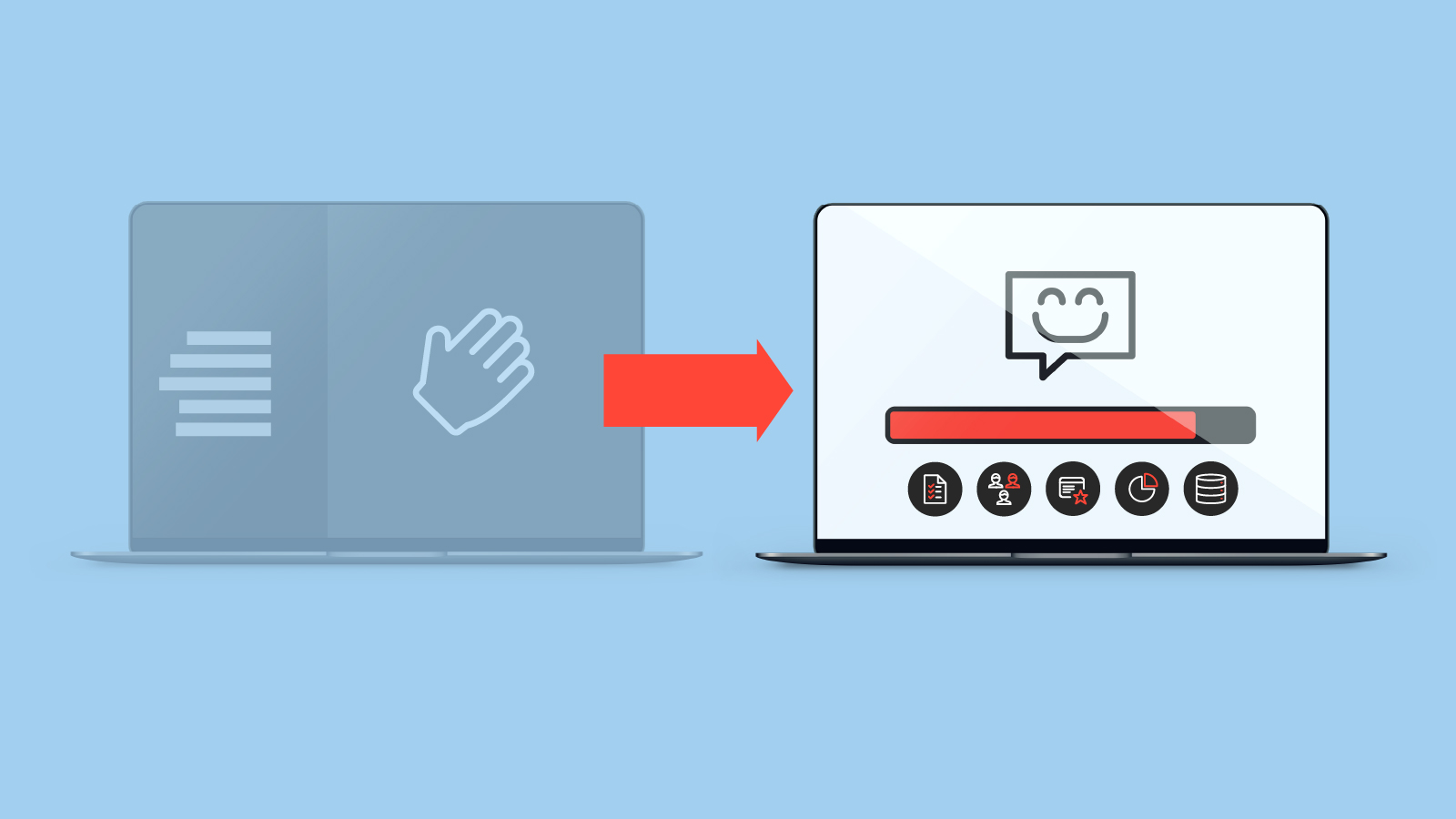
Getting LMS migration right:
FAQ and checklist
When a new learning management system (LMS) is needed or an LMS provider vanishes from the market, sound advice is hard to come by. What other providers are there? And: How do they ensure that the existing data is migrated? What processes are needed for migration and activation? We compiled tips from industry experts, and summarised the key questions and answers in our FAQ checklist.
What should I focus on when selecting a new provider?
The new provider should have sufficient experience in data migration and offer solutions that address each client’s actual needs, rather than pushing a one-size-fits-all approach. Since a 1-to-1 transfer can rarely be achieved, it is crucial to find a provider that offers appropriate consultations and understands the purpose of the different data bits to ensure these are translated to the new system.
Moreover, the migration should be tailored to the specific needs of the company. While this might be achieved with a standard migration in some cases, other scenarios will require the development of customised scripts.
How do migration to the cloud and on-premise migration differ?
If the new provider offers both solutions, the client should not notice a difference. While the actual data transfer works differently, this process would be handled by the provider.
How does the migration work?
Migrations happens in several phases. Andreas Pohl, Director Research & Development at imc recommends: “It generally helps to look at migration as a project in its entirety. In particular, this is important when installing new software in connection with the data migration. This combination is crucial if you want to continue working with the required data in the new system as soon as it goes live. We divide such a project into a total of ten phases.”
These are:
- Consultation, analysis and definition of the data to be migrated as well as processing
- Specification and documentation of the migration process/format
- Script development by the provider in accordance with the agreed specifications
- Data and file preparation by the client in accordance with the agreed specifications
- Running the scripts in the test environment*
- Error output into a log file*
- Quality control by provider and client*
- Data and scripts correction loop*
- Execution of actual migration in the production environment
- Final verification & sign-off
*In complex migration projects, steps 5-8 are carried out several times.
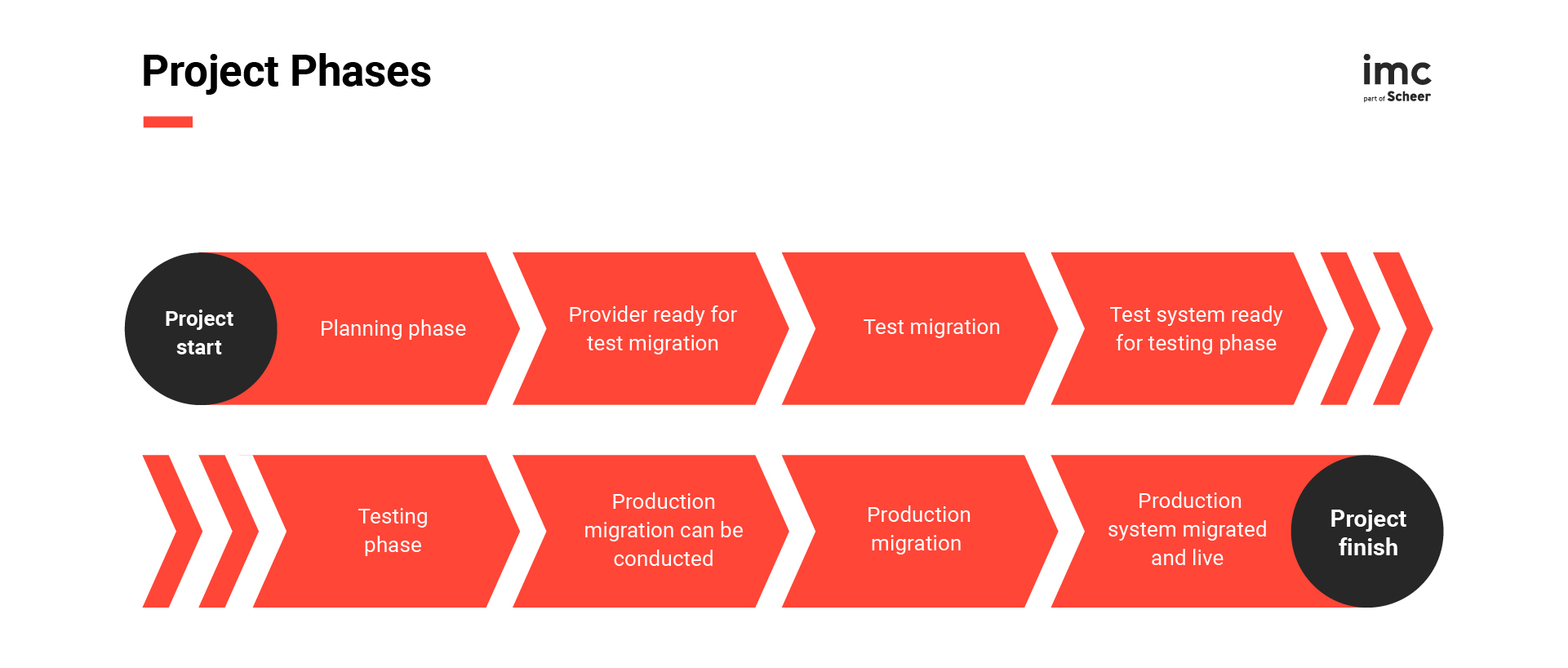
What interfaces should the provider have access to?
An experienced provider will have dedicated migration and import scripts to execute the migration for the client efficiently and ensure the necessary data quality. At the very least, interfaces relevant for learning management systems should be available: e.g. SCORM, AICC, LTI, QTI, as well as proprietary REST-API or other constructs to integrate or feed third-party systems.
What kind of data can actually be migrated?
In principle, (almost) all data can be migrated. The real question whether it’s useful and reasonable to migrate each data set. After all: Data doesn’t migrate itself. Migration involves costs, and needs precise planning and coordination. In an ideal scenario, migration is relatively straightforward for the following types of data:
- User data
- Learning history
- Course and learning content
- Training locations
- Courses and programmes
- Job profiles and competences or competence profiles
- Test questions
When migrating data such as training and course history, the complexity of the content also matters. In some cases, standard processes can be used. However, if extensive information like certificate and competence allocation is linked, special scripts are required.
How long does it take to migrate my LMS?
There are three broad levels of migration projects. Level one would be a straightforward transfer of user data with learning history. This process can be completed within a week. Standard sets with import scripts are available for these cases, facilitating swift migration.
However, the greater the complexity of the system, the longer the migration process. That makes it difficult to specify a timeline without knowing the details. Generally speaking, three months can be realistic for data transfer to test stage.
The project duration also depends on other factors, and it is often not possible to estimate the time involved for each of them. These include:
- Data complexity
- Expected data volumes and their condition (data cleansing required or not?)
- Dependency on functions not developed/configured yet
- Development resources for scripts
- and many more
To conclude, each migration requires excellent planning and preparation, as many factors need to be considered. Due to the dependency on external IT resources or third-party providers, it is important to document migration specifications at an early stage. If an involuntary change of provider makes migration necessary, data availability and access to the legacy system are even more crucial.
At first sight, this may seem like a big effort – but it soon pays off. Each change of provider is also an opportunity to leave legacy issues behind and implement improved processes. Above all, it pays to choose a provider with the necessary experience in the consultation, planning and implementation processes, who can also provide references for successful projects of a similar nature.
A legacy system refers to an established, historically grown application in the area of business software.
In case you have any further questions regarding LMS migration, we're happy to provide more information.
To help you find the right provider, we also recommend our whitepaper on “4 steps to the right LMS – help with navigating the jungle of providers”.

AI in corporate learning
Around the topic of artificial intelligence (AI) are many fears, anxieties and uncertainties. But what AI in the LMS can do and already does is mostly still unclear. We explain the most important terms and applications.

Onboarding slightly different
Already today, onboarding can be integrated into an existing LMS. But this is hardly ever used.
We took a little trip into the (near) future to see what a successful onboarding process could look like.

More information about the LMS
If you would like to find our more about the Learning Management System of imc, please find all information here.
Contact
I have been working in the Marketing & Communication Team at imc since March 2019.
Communication, creative content and social media are my passion. "KISS - Keep it short and simple" is my credo.
To explain complex content in an understandable way and thus make the topic of e-Learning accessible to everyone is an exciting challenge every day.
Privately I love to read, play poker and travel a lot.
I am always happy to receive feedback or suggestions.

Artificial Intelligence:
Useful tool in Corporate Learning or a complete loss of control?
What kind of influence does artificial intelligence (AI) have on learning management systems? Where and how is it being used already? And are all employees about to be continuously monitored by machines?
These are just some of the questions that are also on L&D specialists’ minds as they consider the potential applications of AI in learning systems. And that’s more than enough reason to take on some of these questions and look at them in greater detail.

When it comes to the topic of artificial intelligence, there are a lot of misgivings. Losing sensitive data and constant employee monitoring are only two examples, and learning experts are also having to confront these questions as they develop.
However, imc software expert and AI enthusiast Andreas Pohl thinks it’s important to put things into perspective: “A lot of the fears related to the subject of AI are unfounded. Sure, there absolutely are justified concerns regarding ethical issues that need to be clarified, but when it comes to our Learning Management System (LMS), customers don’t have to worry about the possibility of an evil AI suddenly stealing their data or something like that because it’s not a thing that can actually happen.”
To provide a better understanding of what AI really can and cannot do and how it is used in our LMS, we’ll go over the most important concepts and provide concrete examples of their use.
What is machine learning?
The term is used to describe dynamic algorithms that are able to learn and improve by themselves in such a way that systems can recognize recurring patterns, develop solutions, or provide advice, for example. And the more data that is entered, the more accurate the corresponding predictions.
However, it’s absolutely imperative to define, in great detail, what data is relevant and which rules should be used to analyse data and recognize patterns. In other words, it requires for human beings to actively step in when it comes to the analysis of data and the actual decision-making process.
For more information, visit DeepAI.org.
What is machine learning used for?
One typical example of a machine learning application is image recognition processes. If you teach a machine that a triangle always has three corners and a rectangle always has four, the program will recognize this. It’s important to point out, however, that very exact parameters need to be set up and that if an image doesn’t meet those exact parameters, it won’t be recognized sometimes.
Where in our LMS does machine learning take place?
A typical example consists of automatic recommendations similar to those used by Amazon: “You like A, so check out B.” This is the exact same principle used by the recommendation engines in learning management systems.
Basically put, a person chooses the course they want to take, and the system provides additional recommendations based on this. In fact, these recommendations can also be linked to the person’s learner profile, i.e., their position, their development goals, the courses they’ve already completed, etc.
And the more data that the underlying algorithm has, the better its recommendations will be. This is one of the classic applications of machine learning.
What is deep learning?
Deep learning is a subset of machine learning in which a machine is able to improve its abilities independently and without any human assistance. In contrast to machine learning, people do not influence deep learning results at all, and instead only make sure that the required information is available and that the relevant processes are documented.
In fact, the machine itself carries out the actual analysis and uses it to derive forecasts and/or decisions without assistance on the basis of neural networks, which are connected to each other in a manner that resembles the human brain. Ultimately, the machine is able to make decisions based on these connections.
Now, it’s important to point out that this requires an enormous amount of data, and that this type of data is not found in individual learning management systems.
For more information, visit DeepAI.org.
What is deep learning used for?
One typical example of a machine learning application is image recognition processes. If you teach a machine that a triangle always has three corners and a rectangle always has four, the program will recognize this. It’s important to point out, however, that very exact parameters need to be set up and that if an image doesn’t meet those exact parameters, it won’t be recognized sometimes.
Where in our LMS does deep learning take place?
Generally speaking, using deep learning in learning management systems is still extremely difficult given the lack of sufficient data. In fact, in order to be able to analyse specific patterns and processes, learning platform vendors would have to analyse the data from various companies together, but this isn’t possible due to the fact that this data is subject to very strict data protection regulations and policies.
One concrete example of an area where deep learning algorithms could be used would be learning style recognition. With AI, this recognition could be much more efficient than it has been to date, as it would work uncoupled from manual input and tests.
In this scenario, a system would be able to automatically figure out a learner’s preferences and behavioural patterns and determine the correlation for the corresponding learning results. This means that, from a purely theoretical perspective, your LMS would be able to determine what your learning style is and recommend appropriate content for you based on that.
What is the reality?
In order for the system to be able to use the existing knowledge on how to use learning style recognition to provide appropriate recommendations, all learning contents would have to be available in various versions, that is, as text, images, video, games, or audio.
Needless to say, however, creating these individual contents would entail an enormous amount of time and money, so this approach has seldom been used to date in real-life applications. However, it’s reasonable to expect that these topics will be pretty important in the future, particularly in relation to improving learning efficiency and learning in the moment of need.
In other words, a lot of the fears that people have in relation to the topic aren’t really relevant, or at least not today. However, when it comes to the subject of learning and AI, it will admittedly be necessary to answer ethical questions regarding applications in the future.
Or as Andreas Pohl puts it: “I think we should see AI as an active tool for supporting people. Humans must always be in the foreground of everything, and every single system must provide customers with real added value, regardless of whether it uses AI or not. And at the end of the day, we can always turn any system or tool on or off.”
More about AI and how it can also be implemented in the onboarding process, you can find out in another article of LMS Hot Topics.

Onboarding slightly different
Already today, onboarding can be integrated into an existing LMS. But this is hardly ever used.
We took a little trip into the (near) future to see what a successful onboarding process could look like.

Convincing stakeholders for an LMS
The success of introducing an LMS hinges on those responsible for the launch - and not underestimating them. We have compiled some expert tips and a checklist to help you in convincing your stakeholders.

More information about the LMS
If you would like to find our more about the Learning Management System of imc, please find all information here.
Contact
I have been working in the Marketing & Communication Team at imc since March 2019.
Communication, creative content and social media are my passion. "KISS - Keep it short and simple" is my credo.
To explain complex content in an understandable way and thus make the topic of e-Learning accessible to everyone is an exciting challenge every day.
Privately I love to read, play poker and travel a lot.
I am always happy to receive feedback or suggestions.

Science fiction or near future?
28% of all new recruits quit within their trial period or even fail to turn up on their first day of work. Moreover, employees who receive poor induction are twice as likely to leave as employees who go through an effective onboarding process.
These figures by Haufe should alarm companies: Faced with the ongoing “War of Talents”, new hires are extremely time consuming and costly. Yet, a well-designed onboarding concept can be integrated directly into the existing learning management system (LMS).
To many LMS managers, some of the options available today sound like science fiction. That’s why we embarked on some onboarding time travel into the near future to experience what onboarding might look like.
The first few weeks are crucial for making new colleagues feel welcome in the organisation and helping them become part of the team, as this is the foundation for long-term company loyalty. This requires both empathy and clear onboarding processes. Even larger organisations with existing learning management systems that would provide an optimal infrastructure for efficient onboarding design are often unaware of the opportunities available.
This is why we are following our fictitious employee Hanna in this article to get a glimpse of her slightly different onboarding experience ...

Hanna is excited. She just signed the contract for her new job. She is leaving the big bank where she had been involved in investment advisory services for several years and completed many professional development courses. While most of these followed the traditional face-to-face format, some were delivered online – and often bored her to death.
She will handle similar tasks in her new job with her new employer and fears that she will have to chew through the same dull content all over again. After all, that’s what happened the last time she changed jobs. She lets out a sigh at the mere thought at yet another bog-standard first aid course. Hanna has been a certified first aider and fire protection assistant for years.
Exactly two weeks before her first day at work, a friendly email lands in Hanna’s inbox, asking her to join her new employer’s in-house learning management system. She is quite unsure what to make of that. Surely, they are not expecting her to work already?
Curiosity gets the better of her – and she is in for a surprise. Instead of the expected work assignments, a chatbot welcomes her who resembles a cross between Wall-E and R2D2. The assistant introduces himself as Robby and gives Hanna a virtual tour of her new office, introduces the other team members with a picture, and shows her where they sit. He also reveals her future email address and the (mobile) devices she can expect to find on her desk on her first day.
He asks how she plans to travel to the office, and whether she prefers public transport, car or changing it up. She chooses “both” and promptly receives an overview of all connections and parking options. Robby also shows her who will be sitting at reception on her first day and issue her access card.
The little chatbot then explains which communication tools are used in the company and which other tools Hanna will be working with. She is given the option to take a closer look at these tools before starting her job, but is informed that her manager will personally show her how to use them all in her first week.
Robby ends his tour with the words: “We are looking forward to welcoming you soon. If you have any further questions, simply launch a chat and I will be happy to help you!”
The day of truth has arrived: The first day gets underway and Hanna is stumped. Armed with a smartphone, she is asked to team up with another colleague to complete some type of digital scavenger hunt through the company. When she passes certain offices, she receives a notification along the lines of: “Say Hi to Peter! Peter is responsible for your business trips and finances.”
In her new office, she meets the colleagues Robby had already introduced her to virtually, and she is asked to log into the learning management system from her workstation and complete a test. Instead of a typical mind-numbing multiple choice test, Robby greets her, guides her through the different departments and processes, and invites her to an interactive quiz. Even the training sessions on data protection, cyber security and first aid flow nicely.
When she states her qualifications as a first aider and fire protection assistant, she is asked to upload her certificate and given leave to skip all subsequent questions in this field. Robby also enquires directly whether he may add her as a first aider in the system. Hanna agrees.
The system also adapts to her current knowledge with the subsequent questions, and tailors them accordingly. When the program notices that Hanna already possesses sound knowledge in a field, it either asks more difficult questions or skips certain sections. At the end of the training session, Robby leaves her with the words: “Thank you for your support! I see you are already a real pro. I will adjust your onboarding plan and training accordingly.”
Indeed, Hanna learns only new contents in subsequent training sessions. She is asked to self-assess and is provided with a tailored concept aligned with her personal development goals. She is free to schedule her learning time at her leisure. Her superiors only set a deadline for completing all training units.
Even learning method and approach are tailored to her personal requirements. All training contents is available in various formats, and Hanna can select her preferred system. This involves no additional tests: The algorithm identifies the methods most suitable for Hanna based on the training units she has already completed, and suggests training units using a similar approach. If she doesn’t like them, she is free to switch to other formats at any time.
A few weeks into her job, Hanna suddenly stumbles on a question. She enters it on the intranet and is immediately referred to a matching training session. In addition to the specific training offer, she is also shown which colleagues could assist her with her query. Meanwhile, Hanna is shown as an expert for questions in her specialty areas.
Intuitive tools also let her create her own training sessions in minimal time. Templates are provided in the system, and she can choose between voice-to-text, typed entries, preparing presentations or creating diagrams. Content design is automated and the output is provided in a range of formats. Training is delivered in “learning nuggets”, that is smaller learning units no longer than three minutes each.
By now, Hanna’s profile is after three months filled with a wealth of information. She had already discussed the direction she would like her development to take with her manager in the initial weeks, and they identified the required competences and skills and how she can acquire them. In the next half year, she would like to further improve her English. She is also considering assuming technical management tasks.
To this end, she submitted her self-assessment which must be confirmed by her line manager. A skill profile based on this assessment was set up in the system, which shows target and actual scores. Every time Hanna creates or completes another training unit, the target score increases, and she can see which courses would help her achieve further improvements.
Hanna’s onboarding is complete after six months. She feels like she has arrived and is in good hands. Her line manager now sets up a meeting together with the head of her department. Hanna is slightly uneasy when she arrives for the meeting and wonders whether she had misjudged her achievement after all.
Instead, she finds out that a colleague in another department had unexpectedly handed in his notice. The skills match for the position showed that Hanna already met 80% of the job requirements. While she still needed training in employee management, her superiors are confident that she will master this quickly. Hanna accepts and is promoted after only half a year with the company.
...and in reality?
So far, so good. Which parts of this story are wishful thinking? Which aspects ring true in real life? No doubt, almost every scenario described is possible today - or will be very soon. Nevertheless, companies are only utilising a fraction of these options and opportunities. Creating a dedicated skills profile for each job, developing learning paths and linking these with competences or integrating learning on demand takes time. Yet, investing in these topics – also in combination with skills-based job profiles – and integrating them into the onboarding process pays off, especially when facing skills shortages.
We therefore hope that Hanna’s story leaves the realm of science fiction and becomes reality soon.
Our eBook on competency-based learning offers many helpful tips and, of course, we are happy to assist. Feel free to contact us directly on [email protected].

Courage to the LMS - even as SME!
Not only big companies should have the courage to go for a Learning Management System. In our interview Christian Mai from S&G Mercedes Benz, tells about his experiences with rolling out an LMS in a Small and Medium Enterprise (SME).

Convincing stakeholders for an LMS
The success of introducing an LMS hinges on those responsible for the launch - and not underestimating them. We have compiled some expert tips and a checklist to help you in convincing your stakeholders.

More information about the LMS
If you would like to find our more about the Learning Management System of imc, please find all information here.
Contact
I have been working in the Marketing & Communication Team at imc since March 2019.
Communication, creative content and social media are my passion. "KISS - Keep it short and simple" is my credo.
To explain complex content in an understandable way and thus make the topic of e-Learning accessible to everyone is an exciting challenge every day.
Privately I love to read, play poker and travel a lot.
I am always happy to receive feedback or suggestions.









